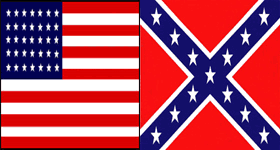 |
Civil War Battles |
|
State War Records |
| AL - AK - AZ - AR - CA - CO - CT - DE - FL - GA - HI - ID - IL - IN - IA - KS - KY - LA - MA - MD - ME - MI - MN - MS - MO - MT - NE - NV - NH - NJ - NM - NY - NC - ND - OH - OK - OR - PA - RI - SC - SD - TN - TX - UT - VT - VA - WA - WV - WI - WY |
The Battle of Fort Gibson
September 16-18, 1864 in Fort Gibson, Oklahoma
 |
|||||||||||||||||||
|
Throughout the summer of 1864, Brig. Gen. Stand Watie, chief of the pro-Confederate Cherokees, and his 7,000-man Indian brigade threatened Union troops in eastern Indian Territory. Their object was the eventual seige and reduction of the territory's strongest Union outpost, Fort Gibson. The Confederate strategy was to threaten the larger Union force at nearby Fort Smith, Arkansas, destroy military and civilian stores in the area, and interpose Confederate troops between Fort Gibson and potential reinforcement from Fort Smith. In theory, the Federals, threatened and unsupplied, would be forced to abandon Gibson.
On June 15th, several hundred of Watie's troops used 3 artillery pieces to sink the Union supply steamer J.R. Williams at Pleasant Bluffs on the Arkansas River. It was loaded with $120,000 worth of food and clothing for 5,000 Union troops and 5,000 pro-Union Indian refugees at Fort Gibson. Then, reinforced by Col. Richard M. Gano and a brigade of Texas cavalry, on July 27-28 and 30th and August 2nd, Watie's force captured the garrison of a Fort Smith outpost; destroyed having operations at Blackburn's Prairie; sacked a Fort Smith commisary post, destroying $130,000 in food and clothing; then shelled Fort Smith. Brig. Gen. John M. Thayer, commanding the District of the Frontier, was inundated by hungry Unionist refugees and called the 2nd Kansas Cavalry for reinforcement, detaching and dispatching a portion of the Kansas troops to duty at Fort Gibson and assigning the rest to Fort Smith.
At a combat at Gunter's Prairie on August 24th, Watie's force attacked 420 of the 2nd Kansas, killing 20. Then 800 of Watie's men and Gano's 1,200 Texans circled northwest of Fort Gibson, attacked a 125-man Union force at Flat Rock Ford on the Grand River, and killed 40. This began the seige of Fort Gibson. Never actually confronted and invested by a Confederate force, the fort was, just the same, cut off from supply and reinforcement.
Survivors of the Flat Rock Ford fight raced to Fort Gibson. Their exaggerated estimate of Confederate strength panicked Unionist there, who put their reserves on alert. Additional refugees arrived. Running short on food, they requested supplies. Thayer dispatched 300 supply wagons and a 610-man escort under the command of Maj. Henry Hopkins to relieve Gibson. On the night of September 19th, at the stockade at Cabin Creek, on the way to Gibson, Watie's and Gano's forces attacked Hopkin's camped wagons. Confederate artillery killed Union horseteams and destroyed the Union's rickety stockade. Several charges, first by Watie's, then by Gano's cavalry, broke and scattered the Union force. The Cabin Creek fight was Watie's last victory and later won him a commedation from the Confederate Congress.
Well over 10,000 soldiers and refugees at Fort Gibson found themselves with only a 2-week supply of food and, after hesitation, Thayer said no relief would come from Fort Smith. Meanwhile, without the Union's knowledge, Watie's poor disciplined force of Indian volunteers dispersed to winter in Texas. Gano could not continue the seige alone and also returned to Texas. For a time, unaware that the danger of Confederate attack had passed, Unionist at Gibson maintained their alert and rationed their supplies.
By the time they realized the seige had ended, the weather had begun turning and other supply problems arose. Unwilling to abandone Gibson, the westernmost Union outpost in hostile territory, the garrison and refugees lived at starvation level through the winter until the Confederate surrender in spring.
